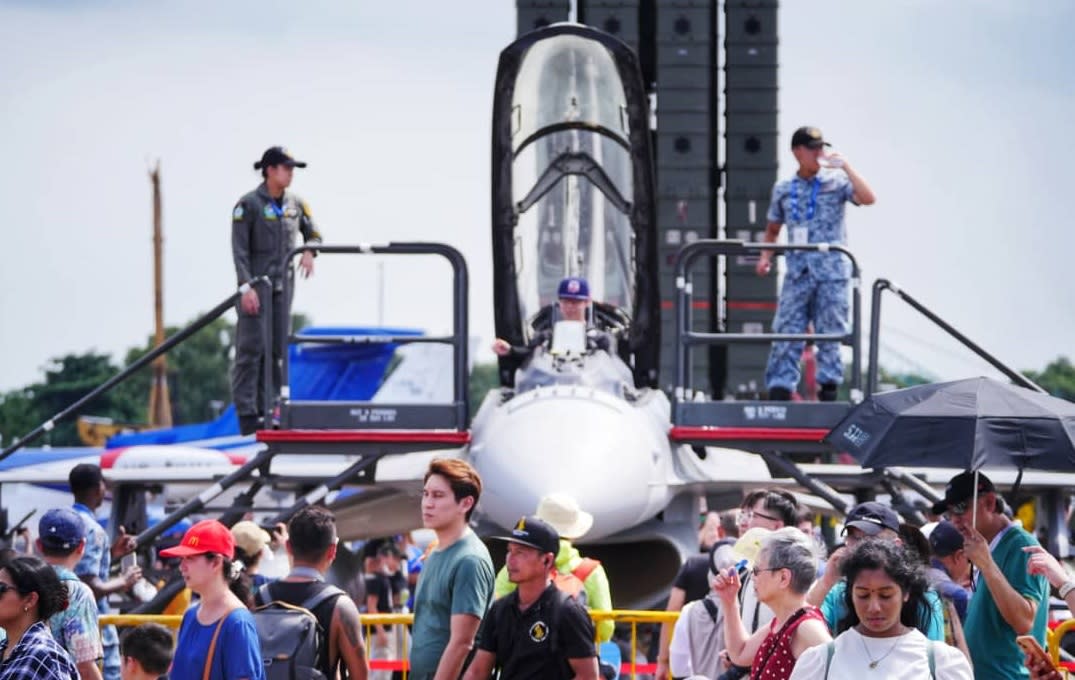Enter the dragon: China poised to capture lion’s share of global arms market

China is pulling out all the stops to make itself a legitimate leader in aerospace technology, if its presence at Singapore Airshow 2024 is anything to go by.
In terms of floor space, it rivals most of the established international players. The range of products on offer is also impressive, although in this instance, they’re mainly in scale model form. They range from guided missiles to unguided rockets, to conventional fighter aircraft, to fighters with low-observables technology, to modern, twin engined, medium-haul airliners.
China brought in three of its newest types to the show. The first is its entry into the medium-haul, single aisle jetliner market, the C-919. It brought two examples – one, a company demonstrator from COMAC the manufacturer, and the other, a unit borrowed from its customer China Eastern Airlines. The second aircraft featured is the ARJ-21 regional jet, also built by COMAC. However, the ‘star’ of the show was the export model of China’s medium attack helicopter, the Z-10ME ‘Ferocious Dragon’, built by Changhe Aircraft Industries Corporation, which is part of China’s AVIC conglomerate. Sadly, only the C-919 took part in the flying display.
In comparison, trouble-plagued Seattle planemaker Boeing’s booth did not excite, although it did have a mock-up of the latest version of the much-vaunted, MiG-killing F-15 Eagle, the EX variant, that is just only now entering service.
Boeing is still reeling from the two deadly crashes in 2018 and 2019 of the then-newest member of its line-up, the ultra-modern 737 MAX. The two crashes claimed the lives of 346 people.
The accidents and subsequent grounding cost Boeing an estimated US$20 billion in fines, compensation, and legal fees, with indirect losses of more than US$60 billion from 1,200 cancelled orders.
On Jan 5 of this year, Boeing made the news again, when a door plug blew out at 16,000 feet, as Alaskan Airlines Flight 1282 was climbing after takeoff. The aircraft suffered an explosive decompression but managed to land safely. No lives were lost in that incident. However, the head of the 737 MAX programme, Ed Clark, an 18-year company veteran, was sacked less than two months after the mid-air blowout that led to withering scrutiny of the manufacturing quality at the US planemaker.
So, it came as no surprise that the Boeing 737 MAX and another new airliner in Boeing’s stable that’s currently in development – the 777X – were no-shows at Singapore Airshow 2024.
Last year, Airbus won the deliveries crown for the fifth consecutive year, beating Boeing. In December 2023, Boeing delivered 67 commercial jetliners compared to Airbus’ 112 airplanes. The year before that, in December 2022, Boeing delivered 69 aircraft, compared to 98 for Airbus. In total, Boeing and Airbus delivered 528 and 735 aircraft in 2023, compared to 480 and 663, respectively, in 2022.
Boeing still has a long way to go before setting new all-time company deliveries records, while analysts predict that Airbus could be back to pre-pandemic delivery levels by next year.
In 2018, before Covid-19 and the first 737 MAX grounding, Boeing delivered 806 jets, a level that will likely not be matched before 2025-2026. Airbus’ record high of 863 deliveries was set in 2019, which could be surpassed this year, but only if Airbus’ global supply chain can keep up. Analysts also believe that Airbus is likely to retain its delivery lead for the considerable future because of its comfortable backlog lead over Boeing. Before 2019, Boeing had out-delivered Airbus every year since 2012.
Even though Airbus is sitting pretty on top of the food chain, troubles in Europe where it is based, is forcing the consortium to be prudent in its spending and policies. This leaves the playing field wide open for the Chinese.
“The Changhe Z-10ME is very well built. It is extremely refined and you can see that a lot of engineering work was put into it,” said aircraft spotter, professional photographer and military enthusiast Pravin Menon.
“There are similarities to the AgustaWestland AW-129 Mangusta, sure... but even if they did take some design elements from that aircraft, it’s obvious that they have refined and improved on the original design to make it better and to suit their needs.”
“China’s engineering prowess has seen a growth spurt in the last 15-20 years. Where once it was known only as a manufacturing giant, it has now evolved into an innovator across a broad spectrum of industries, from automotive to aerospace. It has invested in, and is continuing to invest heavily in research and development. One thing it has going for it is the sheer scale of its manufacturing capability, allowing it to field new types rapidly.”
Pravin added that the scale of China’s participation at Singapore Airshow 2024 is indicative of the country’s seriousness in capturing a huge chunk of the global arms industry, valued at a staggering US$597 billion in 2022.
Main image by Pravin Menon
The post Enter the dragon: China poised to capture lion’s share of global arms market appeared first on Twentytwo13.


